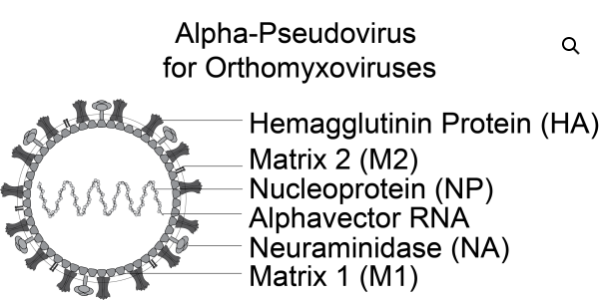Virongy는 혁신적인 바이러스 연구 및 진단 기술을 개발하는 미국의 바이오기업으로,
바이러스 감염 연구와 치료법 개발을 위한 선도적인 솔루션을 제공합니다.

제품 설명
Rapid Alpha-Pseudoviruses for Influenza A
제품 번호
Strain / Reporter Gene / Size 선택
제품 특징
Built-to-order alpha-pseudovirus for Influenza viruses (IAV) with the Hemagglutinin (HA), Neuraminidase (NA), Nucleoprotein (NP), Matrix (M1), and Ion Channel (M2).
A novel rapid hybrid alpha-pseudovirus for Influenza virus (Ha-IAV) and other Orthomyxoviridae viruses are now available at Virongy. Ha-IAV particles are pseudoviruses assembled from the structural proteins of the Influenza virus: Hemagglutinin (HA), Neuraminidase (NA), Nucleoprotein (NP), Matrix (M1), and the Ion Channel (M2). They also encapsulate an alphaviral vector for reporter gene expression. The alpha-pseudoviruses are single-cycle viruses with self-amplifying RNA for rapid quantification of neutralizing antibodies, seroconversion, seroprotection, and entry-inhibiting drugs. These pseudoviruses are BSL-2 safe and ready to use for studying viral entry. Furthermore, we assist our customers in constructing Ha-IAV pseudoviruses at any scale.
Seroconversion: The process by which a person develops detectable antibodies in the blood in response to an infection or vaccination. It marks the point at which the immune system begins to produce a measurable immune response, indicating that the body has recognized the pathogen.
Seroprotection: The level of antibodies in the bloodstream that is considered sufficient to protect against infection. It is often used as a measure of the effectiveness of a vaccine or immune response, indicating that a person has enough antibodies to prevent illness if exposed to the pathogen. For influenza, a serum neutralization titer of 1:40 or greater at a 50% inhibition of viral infectivity is commonly considered a protected titer
Available Strains:
Need a strain not listed here? Ask us about a custom alpha-pseudovirus for your project. For inquiries, please reach out to us via email: info@virongy.com
To enhance your pseudovirus entry, inquire about receiving a complimentary sample of our proprietary Infectin, which significantly enhances productive viral infection in various host cells, thereby boosting the viral infection rate by 3- to 20-fold.
Alpha-pseudoviruses are a new tool for research and development. Unlike traditional lentivirus or VSV-based systems, which rely on their respective core structural proteins, our alpha-pseudoviruses contain all the authentic structural components of the influenza virus, including HA, NA, M1, M2, and NP proteins. Providing a more biologically accurate and reliable system for studying seasonal, pandemic, and avian influenza strains. Our new system utilizes an alphaviral vector allowing for rapid and robust quantification of reporter signal (luciferase or GFP) in target cells in as little as 6 hours. With its rapid customization capabilities to emerging threats, enhanced safety profile, and robust performance, the alpha-pseudovirus platform sets a new standard for virology research and pandemic preparedness.
References
Related links:
Virongy Biosciences의 모든 제품을 만나 보세요!
Products
Services
Viral Neutralization Assay Services
Virongy Biosciences - Exclusive Distributor in South Korea "Morebio" 한국 독점 대리점 "모아바이오"